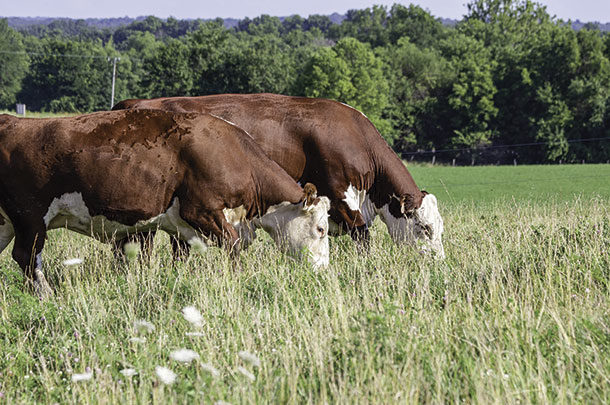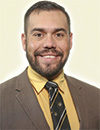The current commercial cow-calf business model is not profitable. Input costs have skyrocketed in the last 20 years, while feeder calf value has not kept pace. Many have given up hope on positive cash flow in the cow business. Economists talk about commercial cow-calf production as being an “asset rich and cash poor” business.
While I do not disagree with economists in principle, it is time to ask ourselves, “What can we do better?” I have one suggestion: Control input costs by feeding less hay.
Initially, I set out to write an article about balancing rations for fall-calving cows in the winter using tall fescue hay. Then it dawned on me that no matter how much extension faculty talk to their clientele about the appropriate timing of hay harvest for optimum quality (mid-May in Missouri), hay is harvested when it is convenient, not when it should be. Also, hay is bought or sold as a commodity feedstuff with little to no information about the nutrient composition.
Many assume a good deal was had after purchasing year-old hay that’s been stored along the fence row for $20 a bale. Then we feed this unknown commodity to cows in the winter for 90-plus days across the Fescue Belt and watch body condition score decline. The easy answer is to backfill any missing nutrients with supplements, but that makes winter cow feeding even more expensive.
A common question to this argument is, “What will I do instead of feeding hay in the winter?” That is the wrong problem to focus on. The real problem is the disconnect from the original business model. The original beef cow business model is to convert sunlight into steak. Pasture forage is the medium of exchange in this relationship. When cow-calf producers focus solely on genetics, weaning weight, quality grade, etc. (cattle-centric performance metrics), they lose sight of the bigger picture. A cattleman has two significant areas of focus: pasture performance and cattle performance. Lots of people brag about 650-pound weaning weights, but no one ever brags about forage yield or how little hay was fed over the winter. Feed represents 60% of annual cow costs. Hay is a big part of that expense in much of the country.
Focus on grazing management
Minimizing purchased and raised feed inputs is important to profitable cow-calf production because you are subsidizing a system in which the cattle require more than the land provides. A typical scenario in Missouri is the producer sets a stocking rate beyond the carrying capacity of the land. A false assumption is that carrying capacity is set in stone. Carrying capacity is both a function of the land and how it is managed.
Continuous grazing systems (cows grazing the same pasture year-round) only harvest a quarter to a third of the forage produced in a year. We use the term “harvest efficiency” or “forage utilization rate” when describing the proportion of forage in a field grazed by a cow. A simple rotational grazing system will increase harvest efficiency from 25% to 40%. That is 60% more feed that ends up in a cow’s mouth. Further intensification of grazing management will raise harvest efficiency above 40%.
Hay is not a more efficient harvest of forage than grazing. It is equal to well-managed grazing, at best. When a field is harvested for hay, 75% to 80% of the forage is removed. On the surface, that far surpasses the harvest efficiency of continuous grazing systems. However, less than 100% of the mechanically harvested forage ends up in a cow’s mouth. We still have to factor in storage and feeding losses. Typical estimates of storage losses are 10%. Feeding losses vary greatly; I assume a 20% loss during feeding in most cases.
Let us put that math into the real world. Starting with 4,000 pounds of forage on a field (3 to 4 tons per acre is typical in tall fescue pastures in Missouri, two-thirds grown in spring and one-third in fall), 75% removal will harvest 3,000 pounds of forage. If I lose 10% of the 3,000 pounds during storage, then 20% of the remaining 2,700 pounds during feeding, I am left with 2,160 pounds of feed that ends up in a cow’s mouth, or 54% (2,160 pounds of the 4,000 pounds) of the forage growth from the field.
Well-managed grazing systems will achieve 54% harvest efficiency in the Fescue Belt. Additionally, research consistently demonstrates that well-managed grazing systems in the Fescue Belt produce about 30% more forage per year than a continuous grazing system. So my 4,000 pounds per acre now becomes 5,200 pounds of harvestable feed over time.
One legitimate criticism of a reduced hay production system centers around the infrastructure required for grazing. Fence and water systems are not free. What is the usable life of a fence and a pond, compared to a tractor and a baler?
When there is too much grass
Many people currently believe that hay harvest is an integral part of forage management in the Fescue Belt. We are blessed to have both a spring and a fall forage growth season. We often have more spring growth than we know what to do with, hence the concept of harvesting excess forage as hay. However, a better model is to stock cows at less than 100% of carrying capacity and use flexible grazing units to harvest growth in times of excess. Taking fall-born calves in as stocker calves is how I would harvest additional feed.
Research conducted at the University of Missouri – Southwest Research Center over the past two years has reported 1.9 pounds average daily gain (ADG) when grazing 1.5 steers per acre on 90% endophyte-infected tall fescue. We turned 570-pound steers out on April 18 and removed 678-pound steers on June 14 each year, gaining 108 pounds per steer over 57 days (162 pounds per acre). Calves were not provided any supplemental feed, nor were the pastures fertilized. Assume we negotiated a 50-cents-per-pound cost of gain deal to graze a neighbor’s calves after weaning. With no inputs, we generated $81 per acre for about 60 days’ work.
A cow-calf operation in the Fescue Belt does not have to be “all hay” or “zero hay.” It is prudent to keep a month of hay around at all times. You never know when drought conditions will arise or when the weather will make grazing impossible. If you come away from this article with nothing else, hear this: You are not going to develop a minimal hay cow-calf business in one year. Try to cut 30 days off of your hay feeding season this year. You still have time to fertilize for fall growth and stockpile tall fescue.
Anyone advocating for low-input cow-calf production is not advocating for starving a profit out of cows. Over 60% of annual cow costs are tied in feed. Invest in fence and water, not tractors and balers. Feed less hay and look at alternative business models for harvesting forage in times of excess growth.








